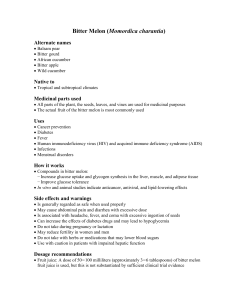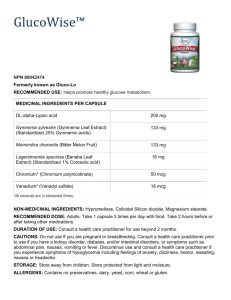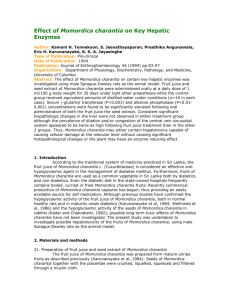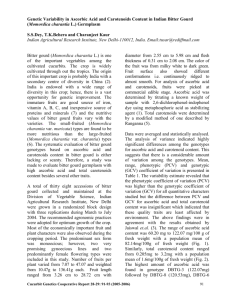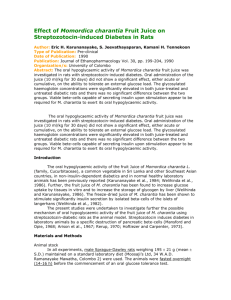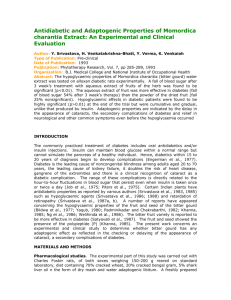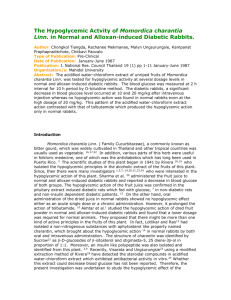Document 13308165
advertisement
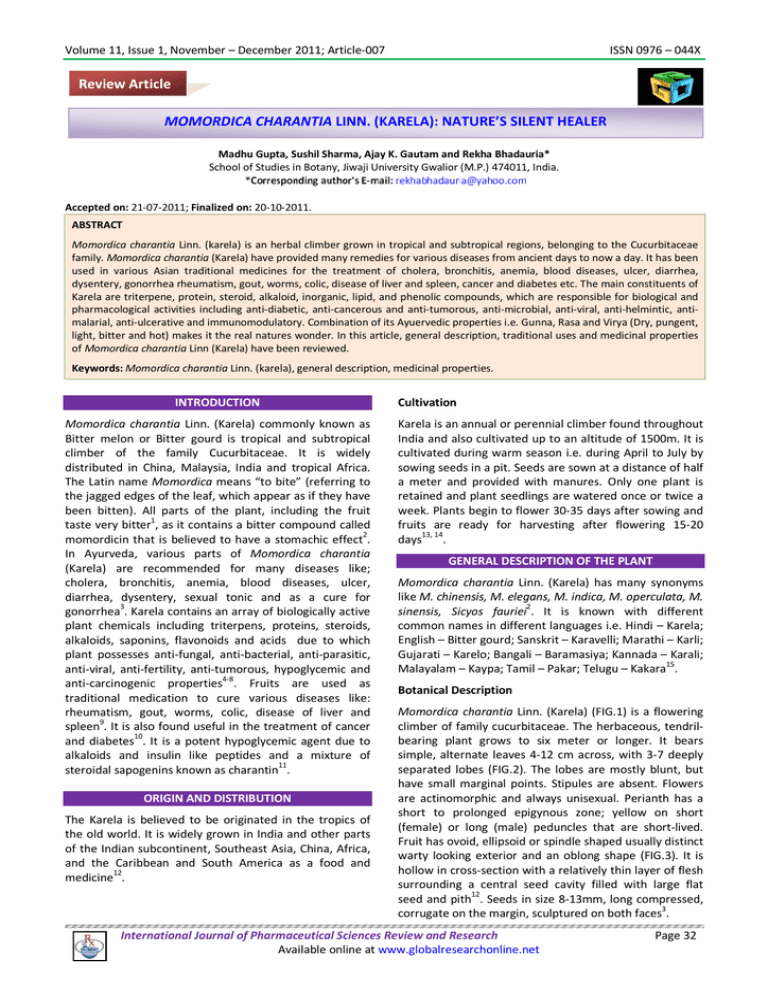
Volume 11, Issue 1, November – December 2011; Article-007 ISSN 0976 – 044X Review Article MOMORDICA CHARANTIA LINN. (KARELA): NATURE’S SILENT HEALER Madhu Gupta, Sushil Sharma, Ajay K. Gautam and Rekha Bhadauria* School of Studies in Botany, Jiwaji University Gwalior (M.P.) 474011, India. Accepted on: 21-07-2011; Finalized on: 20-10-2011. ABSTRACT Momordica charantia Linn. (karela) is an herbal climber grown in tropical and subtropical regions, belonging to the Cucurbitaceae family. Momordica charantia (Karela) have provided many remedies for various diseases from ancient days to now a day. It has been used in various Asian traditional medicines for the treatment of cholera, bronchitis, anemia, blood diseases, ulcer, diarrhea, dysentery, gonorrhea rheumatism, gout, worms, colic, disease of liver and spleen, cancer and diabetes etc. The main constituents of Karela are triterpene, protein, steroid, alkaloid, inorganic, lipid, and phenolic compounds, which are responsible for biological and pharmacological activities including anti-diabetic, anti-cancerous and anti-tumorous, anti-microbial, anti-viral, anti-helmintic, antimalarial, anti-ulcerative and immunomodulatory. Combination of its Ayuervedic properties i.e. Gunna, Rasa and Virya (Dry, pungent, light, bitter and hot) makes it the real natures wonder. In this article, general description, traditional uses and medicinal properties of Momordica charantia Linn (Karela) have been reviewed. Keywords: Momordica charantia Linn. (karela), general description, medicinal properties. INTRODUCTION Momordica charantia Linn. (Karela) commonly known as Bitter melon or Bitter gourd is tropical and subtropical climber of the family Cucurbitaceae. It is widely distributed in China, Malaysia, India and tropical Africa. The Latin name Momordica means “to bite” (referring to the jagged edges of the leaf, which appear as if they have been bitten). All parts of the plant, including the fruit taste very bitter1, as it contains a bitter compound called momordicin that is believed to have a stomachic effect2. In Ayurveda, various parts of Momordica charantia (Karela) are recommended for many diseases like; cholera, bronchitis, anemia, blood diseases, ulcer, diarrhea, dysentery, sexual tonic and as a cure for gonorrhea3. Karela contains an array of biologically active plant chemicals including triterpens, proteins, steroids, alkaloids, saponins, flavonoids and acids due to which plant possesses anti-fungal, anti-bacterial, anti-parasitic, anti-viral, anti-fertility, anti-tumorous, hypoglycemic and anti-carcinogenic properties4-8. Fruits are used as traditional medication to cure various diseases like: rheumatism, gout, worms, colic, disease of liver and spleen9. It is also found useful in the treatment of cancer and diabetes10. It is a potent hypoglycemic agent due to alkaloids and insulin like peptides and a mixture of steroidal sapogenins known as charantin11. ORIGIN AND DISTRIBUTION The Karela is believed to be originated in the tropics of the old world. It is widely grown in India and other parts of the Indian subcontinent, Southeast Asia, China, Africa, and the Caribbean and South America as a food and 12 medicine . Cultivation Karela is an annual or perennial climber found throughout India and also cultivated up to an altitude of 1500m. It is cultivated during warm season i.e. during April to July by sowing seeds in a pit. Seeds are sown at a distance of half a meter and provided with manures. Only one plant is retained and plant seedlings are watered once or twice a week. Plants begin to flower 30-35 days after sowing and fruits are ready for harvesting after flowering 15-20 days13, 14. GENERAL DESCRIPTION OF THE PLANT Momordica charantia Linn. (Karela) has many synonyms like M. chinensis, M. elegans, M. indica, M. operculata, M. sinensis, Sicyos fauriei2. It is known with different common names in different languages i.e. Hindi – Karela; English – Bitter gourd; Sanskrit – Karavelli; Marathi – Karli; Gujarati – Karelo; Bangali – Baramasiya; Kannada – Karali; 15 Malayalam – Kaypa; Tamil – Pakar; Telugu – Kakara . Botanical Description Momordica charantia Linn. (Karela) (FIG.1) is a flowering climber of family cucurbitaceae. The herbaceous, tendrilbearing plant grows to six meter or longer. It bears simple, alternate leaves 4-12 cm across, with 3-7 deeply separated lobes (FIG.2). The lobes are mostly blunt, but have small marginal points. Stipules are absent. Flowers are actinomorphic and always unisexual. Perianth has a short to prolonged epigynous zone; yellow on short (female) or long (male) peduncles that are short-lived. Fruit has ovoid, ellipsoid or spindle shaped usually distinct warty looking exterior and an oblong shape (FIG.3). It is hollow in cross-section with a relatively thin layer of flesh surrounding a central seed cavity filled with large flat 12 seed and pith . Seeds in size 8-13mm, long compressed, 3 corrugate on the margin, sculptured on both faces . International Journal of Pharmaceutical Sciences Review and Research Available online at www.globalresearchonline.net Page 32 Volume 11, Issue 1, November – December 2011; Article-007 In India, it has typical morphology i.e. narrower shape, pointed ends and surface covered with jagged, triangular “teeth” and ridges with green coloration. It has a strong 12 bitter taste among all vegetables . ISSN 0976 – 044X Parts Used The fruits of bitter melon are utilized as vegetable where as the whole plant parts like, fruits, leaves, roots and seeds of bitter melon as medicine. BIOLOGICAL ACTIVITIES The different parts of the Karela contain following various biological activities: Root - Acrid, astringent, bitter. Leaf - Antipyretic, bitter, emetic, purgative. Fruits - Acrid, anthelmintic, anti-diabetic, anti inflammatory, appetizer, bitter, depurative, digestive, purgative, stimulant, stomachic, thermogenic15. Ayurvedic Properties Figure 1: Plant of Momordica Charantia bearing fruits Momordica charantia Linn. (Karela), a vegetable/ medicinal plant is used in the Ayurvedic system of medicine for treating various diseases including diabetes mellitus, measles, fever, hepatitis, itch etc. According to Ayurveda it contains: 1. Gunna (properties) laghu (light), ruksh (dry) 2. Rasa (taste) katu (bitter) and tikta (pungent) 3. Virya (potency) vshna (hot) Combination of these properties makes karela a magic potion for diseases15. BIOCHEMICAL CONSTITUENTS The main constituents of bitter melon (Karela) are triterpene, protein, steroid, alkaloid, inorganic, lipid, and phenolic compounds 5. Figure 2: Leaves of Momordica Charantia Figure 3: Fruits of Momordica Charantia Momordica charantia (Karela) consists the following chemical constituents those are alkaloids, momordicin and charantin (FIG.4), charine, cryptoxanthin, cucurbitins, cucurbitacins, cucurbitanes, cycloartenols, diosgenin, elaeostearic acids, erythrodiol, galacturonic acids, gentisic acid, goyaglycosides, goyasaponins, guanylate cyclase inhibitors, gypsogenin, hydroxytryptamines, karounidiols, lanosterol, lauric acid, linoleic acid, linolenic acid, momorcharasides, momorcharins, momordenol, momordicillin, momordicinin, momordicosides, momordin, momordolo, multiflorenol, myristic acid, nerolidol, oleanolic acid, oleic acid, oxalic acid, pentadecans, peptides, petroselinic acid, polypeptides, proteins, ribosome-inactivating proteins, rosmarinic acid, rubixanthin, spinasterol, steroidal glycosides, stigmastadiols, stigmasterol, taraxerol, trehalose, trypsin inhibitors, uracil, vacine, v-insuline, verbascoside, vicine, zeatin, zeatinriboside, zeaxanthin, zeinoxanthin Amino acidsaspartic acid, serine, glutamic acid, thscinne, alanine, gamino butyric acid and pipecolic acid, ascorbigen, bsistosterol-d-glucicide, citruline, elasterol, flavochrome, lutein, lycopene, pipecolic acid16-18. International Journal of Pharmaceutical Sciences Review and Research Available online at www.globalresearchonline.net Page 33 Volume 11, Issue 1, November – December 2011; Article-007 ISSN 0976 – 044X Fruits consists glycosides, saponins, alkaloids, reducing sugars, resins, phenolic constituents, fixed oil and free acids12. boils and other blood related problems that show up on the skin. Juice of karela is also beneficial in treating and preventing the liver damage19, 20. Leaves are nutritious and have been reported as a source of calcium (1%), magnesium (4%), potassium (7%), phosphorus (5%), and iron (3%); fruits and leaves are great source of B vitamins; Thiamine (vit.B1) 4%, Riboflavin (vit.B2) 4%, Niacin (vit.B3)2%, vit.B6 3%, Folate (vit.B9)13% 16, 2, 17. Leaves are used in treatment of menstrual troubles, burning sensation, constipation, fever (malaria), colic, infections, worms and parasites, as an emmenogogue, measles, hepatitis and helminthiases12. In Guyana traditional medicine, leaf tea is used for diabetes, to expel intestinal gas, to promote menstruation, and as an antiviral for measles, hepatitis, and feverish condition. It is used topically for sores, wound, infections and internally and externally for worms and parasites21. Structure of Important Chemical Constituents Seeds are used in the treatment of ulcers, liver and spleen problems, diabetes, intestinal parasites, high cholesterol, and intestinal gas, heal wounds and 15 stomachache etc. . Roots are used in the treatment of syphilis, rheumatism, boils, ulcer, septic swellings, opthelmia, and in Prolapsus vagenae15, 19. Karela juice helps to reduce the problem of Pyorrhea (bleeding from the gums). Karela capsules and tinctures are widely available in the United States for the treatment of diabetes, viruses, colds flu, cancer, tumors, high cholesterol and psoriasis2. Ethnomedical Uses In India, Momordica charantia Linn. (Karela) used by tribal people for abortions, birth control, increasing milk flow, menstrual disorders, vaginal discharge, constipation, food, diabetes, hyperglycemia, jaundice, stones, kidney, liver, fever (malaria), gout, eczema, fat loss, hemorrhoids, hydrophobia, intestinal parasites, skin, leprosy, pneumonia, psoriasis, rheumatism, scabies, snakebite, vegetables, piles, tonic, anthelmintic, purgative5. PHARMACOLOGICAL ACTIVITY Antioxidant Activity Charantin Figure 4: Phytochemicals: Momordicin and Charantin (Source: Kumar et al., 2010) TRADITIONAL AND MEDICINAL USES Karela has been used in various Asian traditional medicine systems for a long time, as useful for preventing and treating various diseases. Fruits of Momordica charantia (karela) used in asthma, burning sensation, colic, constipation, cough, diabetes, fever (malaria), gout, helminthiases, inflammation, leprosy, skin diseases, ulcer and wound. It has also been shown to have hypoglycaemic properties (antidiabetic) in animal as well as human studies. Juice of the Karela leaves used to treat piles completely. Karela is used as a blood purifier due to its bitter tonic properties. It can heal Different parts of this plant have been used in the Indian medicinal system for a number of ailments besides diabetes. Antioxidant activity of extracted phenolic 22 compound from bitter melon has been reported by . Antioxidant properties of Momordica charantia (Karela) Seeds on Streptozotocin induced-diabetic rats has been studied and results clearly suggest that seeds of Momordica charantia (Karela) may effectively normalize the impaired antioxidant status in streptozotocin induced-diabetes23. Antidiabetic Activity Karela contains bitter chemicals like, charantin, vicine, glycosides and karavilosides along with polypeptide-p a plant insulin, which are hypoglycemic in action and improve blood sugar levels by increasing glucose uptake and glycogen synthesis in the liver, muscles and fat cells. International Journal of Pharmaceutical Sciences Review and Research Available online at www.globalresearchonline.net Page 34 Volume 11, Issue 1, November – December 2011; Article-007 Reports indicate that they also improve insulin release from pancreatic beta cells, and repair or promote new growth of insulin-secreting beta cells. P-Insulin, a polypeptide from the fruits and seeds rapidly decreased and normalized the blood sugar level in rats. Bitter melon contains another bioactive compound i.e. lectin that has insulin like activity. The insulin-like bioactivity of lectin is due to its linking together 2 insulin receptors. This lectin lowers blood glucose concentrations by acting on peripheral tissues and, similar to insulin's effects in the brain, suppressing appetite. This lectin is a major contributor to the hypoglycemic effect that develops after eating Karela. Charantin extracted by alcohol, is a potent hypoglycemic agent composed of mixed steroids which is sometimes used in the treatment of diabetes to 12, 24-27 lower the blood sugar levels . Anticancerous and Antitumorous Activity Bitter melon and its extract inhibit cancer and tumor formation. A novel phytochemical in karela has clinically demonstrated the ability to inhibit an enzyme named guanylate cyclase. This enzyme is thought to be linked to the pathogenesis and replication of not only psoriasis, but leukemia and cancer as well28, 29. Other phytochemicals that have been documented with cytotoxic activity are a group of ribosome-inactivating proteins named alpha and beta momorcharin, momordin and cucurbitacin B. In 1996, Lee-huang et al.30 have developed and patented one more chemical compound “MAP-30”, which was able to inhibit prostate tumor growth. Momordin, another phytochemical has clinically demonstrated anti cancerous activity against Hodgkin’s lymphoma in vivo31 and several other in vivo studies have shown the cytostatic and antitumor activity of the entire plant of bitter melon. Further studies reported that a water extract blocked the growth of rat prostate carcinoma and a hot water extract of the entire plant inhibited the development of the mammary tumors in mice29. Numerous in vitro studies have also demonstrated the anti-cancerous and anti- leukemic activity of bitter melon against numerous cell lines including liver cancer, 28, 29 human leukemia, melanoma and solid sarcomas . Antimicrobial Activity Sankaranarayanan and Jolly32 have clinically demonstrated broad spectrum antimicrobial activity of leaf extracts of Karela. They have reported the in vitro antibacterial activities of water, ethanol, and methanol leaf extracts of Karela against E. coli, Staphylococcus, Pseudomonas, Salmonella, Streptobacillus and Streptococcus; an extract of the entire plant have shown anti-protozoal activity against Entamoeba histolytica. In another study, a fruit extract of Karela has demonstrated antibacterial activity against the stomach ulcer-causing 33 bacteria Helicobacter pylori . Various plant species possessed antimicrobial activity 34-36 against different microorganisms . ISSN 0976 – 044X The antifungal potential of crude ethanolic extract of kaffir lime, bitter cucumber and tobacco has been studied by Thanaboripat et al., (2006)37 against Aspergillus flavus. 21 Jagessar et al., (2008) evaluated antibacterial and antifungal activity of leaf extracts of Momordica charantia (Karela) against Candida albicans, Staphylococcus aureus and Escherichia coli and reported that the ethanol extracts of Momordica charantia (Karela), can be used for controlling E. coli and S. aureus induced diseases. Antifertility Activity Stepka et al., (1974)38 have demonstrated in vivo antifertility effect of fruit and leaf of bitter melon in female animals. Antiviral Activity Karela and its isolated phytochemicals, also has been documented with in vitro antiviral activity against numerous viruses including Epstein-Barr, herpes and HIV 39, 40 viruses . In an in vivo study, a leaf extract demonstrated the ability to increase resistance to viral infections as well as to provide an immunostimulant effect in humans and animals (increasing interferon production and natural killer cell activity)41. Two proteins known as alpha-and beta- momorcharin (which are present in the seeds, fruit and leaves) have been reported to inhibit the HIV virus in vitro39, 40). In one study, HIVinfected cells treated with alpha- and beta-momocharin showed a nearly complete loss of viral antigen while healthy cells were largely unaffected42. In 1996 the inventors of the chemical protein along MAP-30 filed a U.S. patent, stating it was “useful for treating tumors and HIV infections. In treating HIV infection, the protein is administered alone or in conjunction with conventional AIDS therapies43. Another clinical study showed that MAP-30’s antiviral activity was also relative to the herpes virus in vitro44. Anti-Genotoxic Activity Balboa and Lim-Sylianco, (1992)45 have reported that Momordica charantia (Karela) decreases the genotoxic activity of methylnitrosamine, methanesulfonate and tetracycline, as shown by the decrease in chromosome breakage. Anti-Helmintic Activity Momordica charantia (Karela) was found more effective in the treatment of Ascaridia galli46. Ethanol (95%) extract of fruit juice, was found active on Ascaridia galli, whereas, hot water extract of seed at concentration of 1:50 was active on Haemonchus contortus47. Anti-Malarial Activity Karela is traditionally regarded by Asians, as well as Panamanians and Colombians, as useful plant for preventing and treating malaria. Laboratory studies have confirmed that various species of Karela have antimalarial activity. Leaves brewed in hot water to create a tea to treat malaria48. International Journal of Pharmaceutical Sciences Review and Research Available online at www.globalresearchonline.net Page 35 Volume 11, Issue 1, November – December 2011; Article-007 Antineoplastic Activity Various preliminary studies, both in vitro and in vivo, have found antineoplastic activity in crude extracts and 5 purified fractions of M. charantia . In a skin carcinogenesis in mice, aqueous extract of the fruit of M. charantia provide protection against the development of skin tumors and increases life expectancy. The extract also reduced carcinogen-induced lipid peroxidation in the liver, DNA damage in lymphocytes, and significantly activated hepatic glutathione-S-transferase, glutathioneperoxidase, and catalase, all of which had become functionally depressed by exposure to the carcinogen 49 used in the study . Many studies suggest a potentially prophylactic role against carcinogenesis of water-soluble constituents of bitter melon fruit, possibly mediated by their modulatory effect on enzymes involved in the biotransformation and detoxification of xenobiotic 49 substances . ISSN 0976 – 044X 5. Grover JK and Yadav SP: Pharmacological actions and potential uses of Momordica charantia. A Rev J Ethnopharmacol 93(1): 2004; 123-132. 6. Ng TB, Chan WY and Yeung HW: Proteins with abortifacient, ribosome inactivating, immunomodulatory, antitumor and anti-AIDS activities from Cucurbitaceae plants. Gen Pharmacol 23: 1992; 579-590. 7. Scartezzini P and Speroni E: Review on some plants of Indian traditional medicine with antioxidant activity. J Ethnopharmacol 71: 2000; 23-43. 8. Zafar R and Neerja: Momordica charantia-a review. Hamdard Medicine 34: 1991; 49-61. 9. Nazimuddin S and Naqvi SS: Flora of Pakistan No 154, Cucurbitaceae Deptt Botany University Karachi 1984; 56. 10. Duke JA: Handbook of medicinal herbs. CRC Press, Boca Raton FL 1985; 315-316. 11. Agrawal M and Kamal R: In vitro clonal propation of Momordica charantia L. Ind J Biotech (3): 2004; 426-430. 12. Kumar DS, Sharathnath KV, Yogeswaran P, Harani A, Sudhakar K, Sudha P and Banji D: A medicinal potency of Momordica charantia. Int J Pharmaceu Sci Rev Res 1(2): 2010; 95. 13. Indian Medicinal Plants: A Compendium of 500 species, Orient Longman Ltd., Madras 4: 1995; 48-51. 14. Nadkarni KM: Indian Materia Medica. Vol 1, Popular Prakashan 1993; 805-806. 15. Jadhav D: Medicinal plants of Madhya Pradesh and Chhattisgarh 2008; 213-214. 16. (http://www.singleherbs.org/products/karela.htm) 17. Dhalla NS, Gupta KC, Sastry MS and Malhotra CL: Chemical composition of the fruit of Momordica charantia Linn. Ind J Pharmacol 23: 1961; 128. 18. Braca A, Siciliano T, D’Arrigo M and Germano MP: Chemical composition and antimicrobial activity of Momordica charantia seed essential oil. Fitoter 79: 2008; 123-125. 19. Agharkar SP: Medicinal plants of Bombay Presidency. Scientific Publishers, Jodhpur 1953. 20. Garau C, Cummings E, Phoenix DA and Singh J: Beneficial effect and mechanism of action of Momordica charantia in the treatment of diabetes mellitus a mini review. Int J Diab Metabol 11: 2003; 46-55. 21. Jagessar RC, Mohamed A and Gomes G: An evaluation of the antibacterial and antifungal activity of leaf extracts of Momordica Charantia against Candida albicans, Staphylococcus aureus and Escherichia coli. Nat Sci 2008; 6(1). 22. Horax R, Hettiarachchy N and Islam S: Total Phenolic contents and phenolic acid constituents in four varieties of bitter melons (Momordica charantia) and antioxidant activities of their extracts. J Food Sci 2005; 70. 23. Sathishsekar D and Subramanian S: Antioxidant properties of Momordica Charantia (bitter gourd) seeds on Streptozotocin induced diabetic rats. Asian Pacific J Clin Nutr 14(2): 2005; 153-158. Antiulcerative and Immunomodulatory Activity The traditional use of bitter melon for treating gastrointestinal ulcers is recommended. Dried fruits powder administered in filtered honey have significant and dose-dependent activity against ethanol-induced ulcerogenesis in rats. Various studies have found both immunostimulating and immunosuppressive effects, due to extracts and isolated constituents of bitter melon 16. It is highly dependent on the type of extract or constituent, its dosage and its route of administration. CONCLUSION Momordica charantia Linn. (Karela) is a potential herbal plant which is used as vegetable and medicine. It is a good source of various medicinally important biochemicals like, triterpene, protein, steroid, alkaloid, and phenolic which are responsible for its biological and pharmacological activities including anti-diabetic, antioxidant, anti-cancerous and anti-tumorous, antimicrobial, anti-fertility, anti-viral, anti-helmintic, antimalarial, anti-ulcerative and immunomodulatory etc. on the basis of all these properties Momordica charantia Linn. (Karela) can be utilized as a good source of nutritional, medicinal and pesticidal agent. REFERENCES 1. Taylor L: Technical Data Report for Bitter melon (Momordica charantia) Herbal Secrets of the Rainforest. nd 2 edition. Sage Press 2002. Austin. 2. (www.rain-tree.com\bittermelon.htm) 3. Kirtikar KR and Basu BD: Indian medicinal plant. 1987; 1130. 4. Beloin N, Gbeassor M, Akpagana K, Hudson J, de Soussa K, Koumaglo K and Arnason JT: Ethnomedicinal uses of Momordica charantia (Cucurbitaceae) in Togo and relation to its phytochemistry and biological activity. J Ethnopharmacol 96: 2005; 49-55. International Journal of Pharmaceutical Sciences Review and Research Available online at www.globalresearchonline.net Page 36 Volume 11, Issue 1, November – December 2011; Article-007 ISSN 0976 – 044X 24. Virdia J, Sivakamia S, Shahanib S, Sutharc AC, Banavalikar MM and Biyanic MK: "Antihyperglycemic effects of three extracts from Momordica charantia." J Ethnopharmacol 88(1): 2003; 107-11. 36. Johnsona DB, Shringib BN, Patidara DK, Chalichema NSS, Javvadia AK: Screening of antimicrobial activity of alcoholic & aqueous extract of some indigenous plants. Indo-Global J Pharmace Sci 1(2): 2011; 186-193. 25. Khan BB and Flier JS: "Obesity and insulin resistance." J Clin Investigation 106:2000; 473-481. 37. 26. Shetty AK, Kumar GS, Sambaiah K and Salimath PV: "Effect of bitter gourd (Momordica charantia) on glycaemic status in streptozotocin induced diabetic rats." Plant Foods Human Nutr 60: 2005; 109-12. Thanaboripat D, Chareonsettasilp S, Pandee K and Udomwongsup K: Inhibitory effect of Kaffir lime, Bitter cucumber and Tobacco extracts on the growth of Aspergillus flavus. KMITL Sci Technol J 6(1): 2006; 18-24. 38. Stepka W, Wilson KE and Madge GE: “Antifertility investigation on Momordica.” Lloydia 37(4): 1974; 645c. 39. Bourinbaiar AS and Lee-Huang S: Potentiation of anti-HIV activity of the anti-inflammatory drugs dexamethasone and indomethacin by MAP30, the antiviral agent from bitter melon. Biochem Biophy Res Commun 208(2): 1995; 779. 40. Lee-Huang S, Huang PL, Chen HC, Huang PL, Bourinbaiar AS, Huang HI and Kung HF: “Anti-HIV and anti-tumor activities of recombinant MAP30 from bitter melon.” Gene 161(2): 1995; 151–56. 41. Huang TM: “Studies on antiviral activity of the extract of Momordica charantia and its active principle.” Virologica 5(4): 1990; 367–73. 42. Lee-Huang S: “MAP 30: a new inhibitor of HIV-1 infection and replication.” FEBS Lett. 272(1-2): 1990; 12–18. 43. Lifson JD, Mcgrath MS, Yeung HW and Hwang KM: “Method of inhibiting HIV.” U.S. Patent #4795739 1989; 128. 44. Bourinbaiar AS and Lee-Huang S: “The activity of plantderived antiretroviral proteins MAP30 and GAP31 against Herpes simplex virus in vitro.” Bioche Biophy Res Commun 219(3): 1996; 923–29. 45. Balboa JG and Lim-Sylianco CY: Antigenotoxic effects of drug preparations Akapulko and Ampalaya. Philippine J Sci 121(4): 1992; 399. 46. Lal J, Chandra S, Raviprakash V and Sabir M: In vitro anthelmintic action of some indigenous medicinal plants on Ascaridia galli worms. Ind J Physiol Pharmacol 20(2): 1976; 64. 47. Grewal RC: Medicinal plants 2000. 48. http://www.gmanews.tv/story/35962/Ampalaya-tabletsout-soon-for-diabetics. 49. Ganguly CDeS and Das S: Prevention of carcinogeninduced mouse skin papilloma by whole fruit aqueous extract of Momordica charantia. European J Cancer Preview 9(4): 2000; 283-288. 27. Lotlikar MM and Rao MRR: Pharmacology of a hypoglycaemic principle isolated from the fruits of Momordica charantia Linn. Ind J Pharmacol 28: 1966; 129. 28. About Herbs: Bitter Melon": Memorial Sloan-Kettering Cancer Center. http://www.mskcc.org/mskcc/html/ 69138.cfm, Retrieved 2007; 12-27. 29. 30. 31. 32. Cunnick JE, Sakamoto K, Chapes SK, Fortner GW and Takemoio DJ: Induction of tumor cytotoxic immune cells using a protein from the bitter melon (Momordica charantia). Cellular Immunol 126(2): 1990; 278. Lee-Huang S, Bourinbaiar AS, Huang P, Huang HI and Huang PL: Plant proteins useful for treating tumors and HIV infection. U.S. Patent #5484889 1996; 1-28. Terenzi A, Boloqnesi A, Pasqualucci L, Flenghi L, Pileri S, Stein H, Kadin M, Biqerna B, Polito L, Tazzari PL, Martelli MF, Stirpe F and Falini B: “Anti-CD30 (BER=H2) immunotoxins containing the type-1 ribosomeinactivating proteins momordin and PAP-S (pokeweed antiviral protein from seeds) display powerful antitumor activity against CD30+tumor cells in vitro and in SCID mice.” Braz J Haematol 92: 1996; 872–79. Sankaranarayanan J and Jolly CI: Phytochemical, antibacterial, and pharmacological investigations on Momordica charantia Linn. Emblica offidnalis Gaertn. and Curcuma longa Linn. Ind J Pharmaceu Sci 55(1): 1993; 6. 33. Yasilada E, Gurbuz I and Shibata H: “Screening of Turkish anti-ulcerogenic folk remedies for anti-Helicobacter pylori activity.” J Ethnopharmacol 66(3): 1999; 289-93. 34. Ziad D, Elias A and Roula AM: Antibacterial activity of Rheum rhaponticum, Olea europaea, and Viola odorata on esbl producing clinical isolates of Escherichia coli and Klebsiella pneumoniae. Int J Pharmaceu Sci Res 2(7): 2011; 1669-1678. 35. Ghosh P, Chakraborty P and Ghosh GB et al.: Antibacterial, antifungal and phytotoxic screening of some prepared pyrazine derivatives in comparison to their respective αdiketo precursors. Int J Pharmaceu Sci Res 2(7): 2011; 1687-1692. ******************* International Journal of Pharmaceutical Sciences Review and Research Available online at www.globalresearchonline.net Page 37
